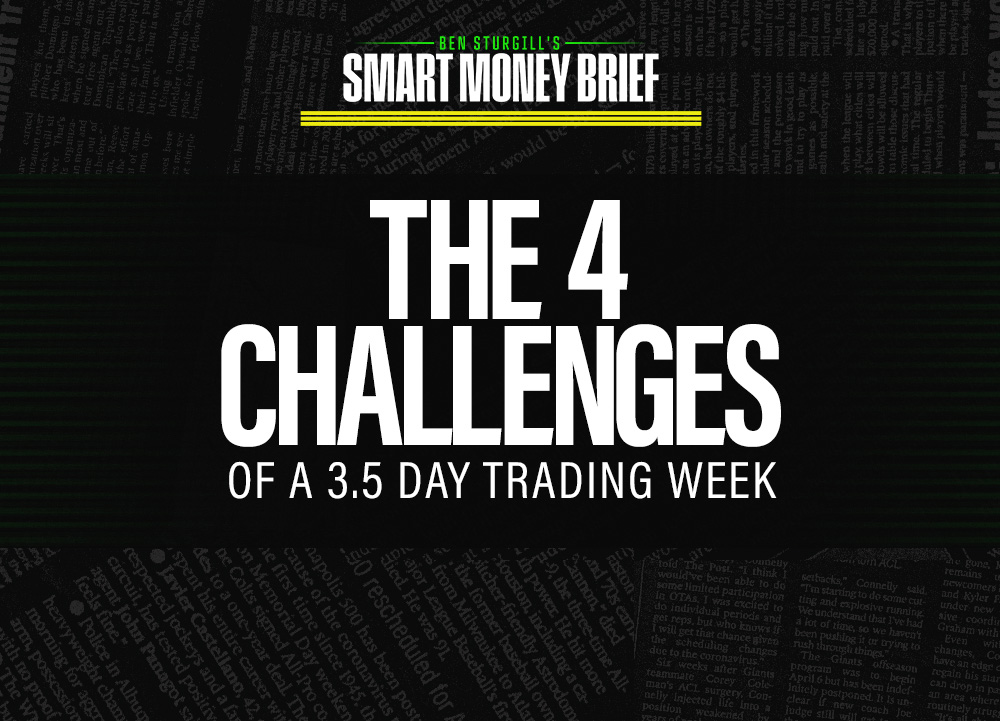Good morning, traders…
Exactly one year ago, I watched my friend blow up his account … right before Thanksgiving.
He had a good setup: A clean breakout with strong volume on a beautiful chart.
The first half of the day was smooth sailing. He even sized up because everything looked perfect.
Then lunchtime hit. The volume disappeared. The chart flattened out. His position got stuck in a 30-cent spread.
The stock continued to chop sideways for two hours while time decay ate his premium.
By Friday’s early close, his winning setup had turned into a loss.
Not because his trading was bad, but because he didn’t consider the calendar.
This isn’t a normal trading week…
So don’t treat it like one.
Markets are closed all day on Thursday for Thanksgiving, and they close at 1:00 PM ET on Friday (half day).
3.5 trading days instead 5.
Time decay compresses into fewer days. Volume dies after lunch on Wednesday. Traders go on vacation early. Liquidity disappears faster than usual.
If you trade a shortened week like a normal one, you’re gonna have a bad time…

Understanding these nuances will help you steer clear of losses (and maybe even stack some gains) during a week when most traders will make easily avoidable mistakes.
Ready To Crush The 3.5 Day Trading Week? Start Here…
Challenge #1: Faster Time Decay
The biggest headwind you’ll face trading options this week? Timing.
Time decay doesn’t pause just because the market takes a day off.
You normally get 5 days of decay spread across the week.
This week, you’re getting the same decay compressed into 3.5 trading days.
I suggest treating this Wednesday as if it were Friday.
If weeklies don’t prove themselves by Tuesday midday, exit the position.
WARNING: If you hold long options into the holiday, you’re paying for a meaningless day where those contracts can’t move.
Challenge #2: Less Volume
Friday is an actual half-day. But Wednesday becomes a pseudo-half-day.
Varying travel schedules lead to many traders taking off early for vacation, resulting in less trading volume.
When volume dries up, you get fewer clean breakouts. You get more fakeouts. You get wider spreads. You get market maker games.
That’s why the Smart Money positions early. You can bet the whales are already in their positions for this week.
You should do the same. If you’re not already in open positions by this morning, be conservative.
Don’t open new ones unless they check all of your boxes.
Challenge #3: Wider Bid-Ask Spreads
Market makers adjust to the shortened week by widening bid-ask spreads on options.
This is especially apparent in short-dated weeklies.
If you normally see 5-10 cent spreads, don’t be shocked to see 20-40 cents.
Wider spreads create more slippage, worse fills, and harder-to-manage risk.
Before entering any trades this week, look at the difference between the bid and the ask.
If the spreads look ridiculous, don’t trade those contracts.
Challenge #4: Distorted Earnings Reactions
When earnings fall inside or near the holiday week, pre-earnings implied volatility can be inflated … while post-earnings moves can be muted.
Sometimes, no follow-through happens the next day. Sometimes, all the follow-through happens in the first hour.
This happens because fewer traders are active during a holiday week.
Institutions avoid adding major exposure. Funds don’t reposition into low-volume environments.
For earnings trades in a shortened week, take profits faster. Expect weaker momentum. Don’t expect multi-day continuation.
Or, you could remove all of the guessing games and start using my proprietary earnings algorithm to trade this season like a pro.
Since its inception, my Earnings Edge system has delivered:
- 2,500 trades total*
- 198 winners of 100% or more (counted once each, even if repeated entries)*
- 90% overall win rate*
This Could Change How You Trade … FOREVER.
How To Crush The 3.5 Day Week
Step 1: Understand that conditions are different this week. Trading gets more difficult. Time decay hits harder. Liquidity dries up faster. Spreads widen.
Step 2: Scale down to 1 contract, half-size, on A+ setups. You can be more aggressive only if Smart Money flow is off the charts.
But don’t force your normal size into abnormal conditions.
Trade smaller. Take profits sooner. Position early.
Weeks like these make it obvious why Wall Street spends billions of dollars building robots to trade the stock market.
An AI algorithm doesn’t forget it’s a shortened week, mistime its trades, or oversize into ramping time decay.
Wouldn’t it be nice to have those same advantages?
It would’ve been impossible to do so … until now.
You Have No Excuses This Black Friday…
Start Trading With AI for Just $1.

Happy trading,
Ben Sturgill
*Past performance does not indicate future results


